![]()
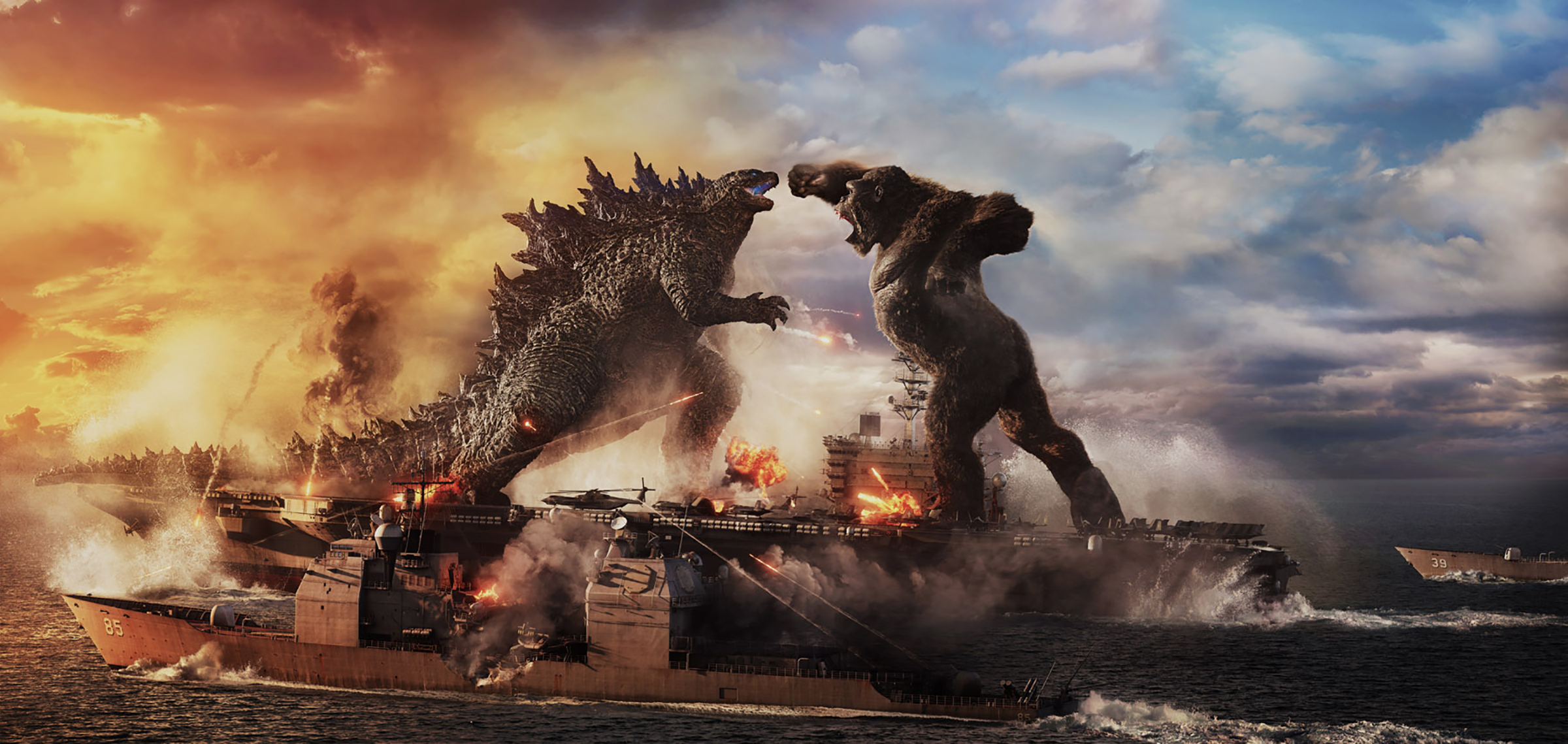
I’m not sure if I should be elated or disappointed after watching Godzilla vs. Kong (GvK), the latest film (2021) in the Legendary/Universal, Godzilla/MonsterVerse saga. That’s Kong, not King Kong, by the way, because of a squabble over licensing rights, but, yes, it’s that Kong in person if not name. The kaiju formerly known as…
Almost two hours of Godzilla and the gang onscreen, with tremendous monster fights, should be a delight for any kaiju aficionado (as readers here know I am…), and I always revel in another Godzilla (or Kong) film added to my collection, but I can’t help feel something was missing.
Okay, spoiler alert: if you plan to see it (and you should), watch the film before you read my rambling musings here, because I may reveal stuff you didn’t expect. But, as a reader, I hope you will be amused or at least informed by them.
Sure the CGI was terrific, the fight scenes exciting, the revelation of the Mechagodzilla robot unexpectedly delightful (and a great design; see below). And the network-wired, actual-size skull of Ghidorah (aka Monster Zero) was a treat (although not given nearly enough screen time to fully appreciate it). But still… it was, I don’t know, often flat. Predictable.
I suppose I wanted awesome and although the film teased me with it, and tossed us a bit now and then, it didn’t quite deliver overall. But it didn’t skimp on the kaiju, as has sometimes been said of the 2014 and 2016 Godzilla films. You get Godzilla right from the start. Kong is not far behind.
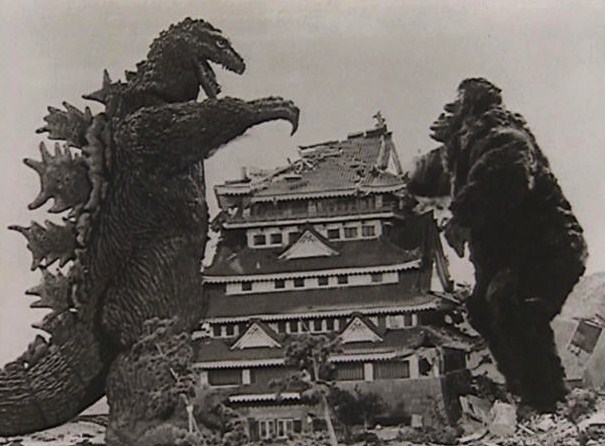 It’s not a remake of the original 1962 Toho film King Kong vs. Godzilla (US release in ’63), but it has its roots in that film (which was, by the way, the first Godzilla film shot in colour) and offers lots of nods and winks from it. Stuff was added, stuff was taken away, and everything is modernized and techy. And made much, much bigger.
It’s not a remake of the original 1962 Toho film King Kong vs. Godzilla (US release in ’63), but it has its roots in that film (which was, by the way, the first Godzilla film shot in colour) and offers lots of nods and winks from it. Stuff was added, stuff was taken away, and everything is modernized and techy. And made much, much bigger.
In’62 Godzilla stood a mere 45metres (147 feet, although some sites say 50m/162ft) tall; King Kong was given a grown spurt for the film to reach that height from his original 15m (50 ft officially, but shown at 7m or 24 ft in the city scenes) height in the 1933 film. In 2021, they are both more than double that: Godzilla is 120m, and Kong 102m tall. But then, the skyscrapers they battle in have grown correspondingly, too, often towering over the kaijus.
That’s all okay: all of the MonsterVerse films are a new take; a re-visioning of Godzilla and the franchise kaiju, much like the new Planet of the Apes films are a new vision of the original series. And deservedly so: the first Godzilla was released almost 70 years ago (yet still stands up). I’m pumped that the franchise still lives on after almost 70 years, with new ideas and new scripts, and bigger, badder, better monsters. I just think there’s still some room for improvement.
It’s easier for those of us who have watched the earlier films to understand and appreciate the remakes and homages, I suppose. And I’ve been watching for almost as long as the franchise has been around. The original ’62 film, campy as it seems today, still holds a place in the hearts of fans, but we have room for the new ones, too.
GvK is almost too smooth, too polished, the plot too pat. It’s a very American Godzilla film: big, bold, brash, lots of action, running, flying, escaping, getting caught, guns, big monsters destroying stuff, more guns, and oceans of CGI. It never descends to subtlety or intellectualism. Dialogue is, for the most part, short, staid, and forgettable. The two teens and their adult conspiracist companion are sometimes witty, however, despite the stereotyped characters they play. Aside from those three, most of the human characters are cardboard and their dialogue wooden. But who’s listening? Bring on the kaiju!
Best actor by a kilometre is Jia, played by a young Kaylee Hottle. (She plays the sole survivor of Skull Island’s Kong-worshipping Iwi tribe). She is, in real life, deaf and plays a deaf child who has a special connection with Kong (teaching him sign language, which creates some room for future films in which Kong and humans communicate and cooperate). She gives real depth to the character and has the only really emotional, moving moments on screen. She provides almost all of the much-needed human drama in the film (the finger-to-finger moment is touching). Watch the special features to learn more about her.
Kong is really well portrayed in CGI: rougher, older, and wiser. I could relate all too well to the passage of time he showed, but at least he didn’t have a pear-shaped “dad bod” after all that time. And despite my affection for Big G, Kong had most of my sympathies in the film.
It’s loud. Monsters gotta scream and roar, especially when smashing things (or each other), often mixed with battleships firing their guns, depth charges exploding, screaming jets firing missiles, thunderstorms, buildings crashing, crowds screaming… louder and louder. I suppose that makes the quiet scenes more compelling.
There are way too many questions that remain unanswered after the film. What’s with the dome over Skull Island? And what’s going on with the island itself? How did they get Kong onto the ship? Why can’t we see anyone’s breath (Kong’s in particular) freezing in the bitterly cold Antarctic? Who built the throne room in the hollow earth? What are the blue-veined rocks and why are they the only ones floating in the gravity intersection? Why has no one leaked the Mechagodzilla news from APEX Cybernetics? How did the Mechagodzilla become sentient? What happened to Ghidorah’s skull afterwards? What’s the axe made of, who made it, and what’s its power (it has this Kong-as-Thor feeling; apparently it’s made from “the dorsal fin of a Godzilla ancestor” although that’s not said in the film)? What’s behind the rivalry of these kaiju? Why is APEX so determined to wipe out Godzilla?
An extended version (or director’s cut) of the film is probably required to fill us in on these and other questions. The initial compilation before editing was allegedly about five hours long, but was trimmed to just under two for release. Methinks in doing so, a little too much was cut, and too many gaping holes resulted. Maybe 2.5-3 hours would have been better.
The rampage in Hong Kong where most of the city appears to be trashed almost seems inconsequential, albeit visually entertaining. The damage scenes in Shin Godzilla were horrific and realistic; even the rampage scenes in the ’54 Godzilla were deeply moving; these seem more a caricature; CGI rubblization. You feel more for the kaiju than the inhabitants of the apartments they squash. You don’t see people trapped in towers falling to their death or being crushed by a kaiju flung into their building. Perhaps that’s a good thing, but it feels like Hong Kong is mostly empty.
The fight scene in the water and on the deck of the aircraft carrier was a hoot, although you have to wonder how anything could stay afloat when one of these giant beasts got aboard, much less two. Hundreds of sailors drowned, a few billion dollars of naval hardware sunk; move on, nothing to see here.
And then, suddenly, Kong is in some giant net held aloft by a fleet of helicopters (Where did they come from? Where did they get a net that big and strong?) and being flown to the Antarctic. Huh? Do they really have all that lifting power? How far away were they and how did they have enough fuel to get back? And why didn’t Kong struggle and get out of the net?
The old days when Godzilla was a guy in a rubber suit trampling through meticulously crafted miniatures may be long past us, but those scenes had a sense of doom and desperation this new film seems to lack. Sure there are a few scenes where it all seems to gel, and people get hurt, but overall, I didn’t get much of a sense that the monster battles in Hong Kong or elsewhere really affected people very much. Sure, machines and buildings get demolished, but you don’t get the human tragedy very strongly. I felt it needed to be more emotional and scary.
Just an aside: these kaiju must produce a lot of waste products. Seriously large amounts. Back in 2014, a scientist calculated the Godzilla from the 2014 film would produce about “12,921,400 gallons” of urine per day (American gallons, not imperial, I assume), equal to filling roughly one-quarter of a hold of the largest production oil tankers (more if he suffers from polyuria…). That’s about 48,912,797 litres. And that’s just number one… for only one kaiju. Fortunately, we are not shown this on screen, but it does make one wonder… (and don’t get me started on kaiju breeding and sex… since we only ever see one of each, these may even be creatio ex nihilo…)
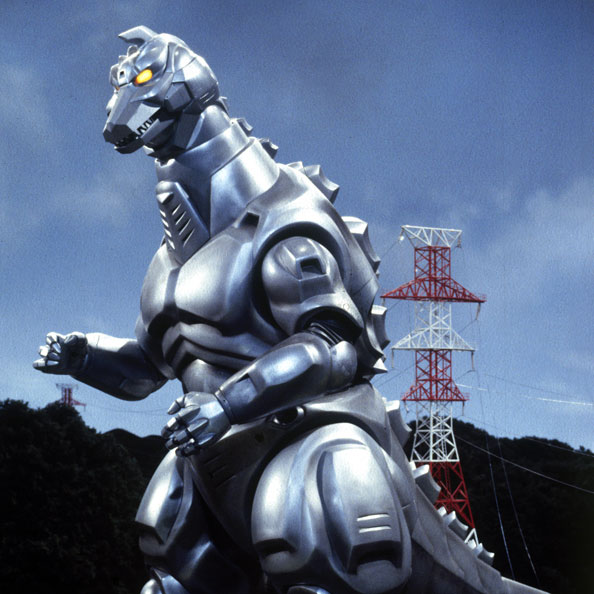 Mechagodzilla (aka Kiryu) is the uber-villain, and rightfully so, but gets frankly too little screen time for its threat size and terrific appearance: roughly five minutes almost all of which are the battle sequence at the end of the film. It wasn’t very well developed as a kaiju, especially since it gained intelligence rather abruptly (and inexplicably) before jumping into battle. MechaG’s motives and intentions are not very well explained, much less its power source and intelligence. It should have been more prominent in non-battle scenes. I want the kaiju universe more fleshed out (if that can be properly said of a robot).
Mechagodzilla (aka Kiryu) is the uber-villain, and rightfully so, but gets frankly too little screen time for its threat size and terrific appearance: roughly five minutes almost all of which are the battle sequence at the end of the film. It wasn’t very well developed as a kaiju, especially since it gained intelligence rather abruptly (and inexplicably) before jumping into battle. MechaG’s motives and intentions are not very well explained, much less its power source and intelligence. It should have been more prominent in non-battle scenes. I want the kaiju universe more fleshed out (if that can be properly said of a robot).
The original Mechagodzilla first appeared in 1974 in Toho’s 14th film in the Godzilla franchise (Godzilla vs Mechagodzilla) and was played by a guy in a metal/rubber suit like his opponent (but made from “space titanium” we’re told by a scientist in the film). Maybe a bit camp and corny looking by today’s CGI standards, but I liked that. It’s a cool kaiju and one of Godzilla’s most dangerous opponents. And, of course, there was the other kaiju and guardian deity, King Caesar in that film who also battled MechaG and lost… but let’s stick with the robots.
MechaG re-appeared in the 1975 sequel, Terror of Mechagodzilla, which was one of the better films in the late Showa period because Ishiro Honda, the original director of the Godzilla franchise, was brought back to make the film. And it has a better soundtrack, one based on the original theme. It was also the last film Honda directed.
It also featured Titanosaurus, an amphibious dinosaur under control of the Black Hole 3 aliens, and thus allied to the resurrected MechaG 2. Titanosaurus stands 60 metres (196 feet) tall and is a formidable enemy. The two descend on Tokyo and wreak the expected havoc. Godzilla arrives to challenge both, and wins the two-on-one battle after INTERPOL weakens Titanosaurus with a sonic wave oscillator. The dinosaur doesn’t return in subsequent films. (I started watching these first two Mechagodzilla films again this past week to look for references and inspirations).
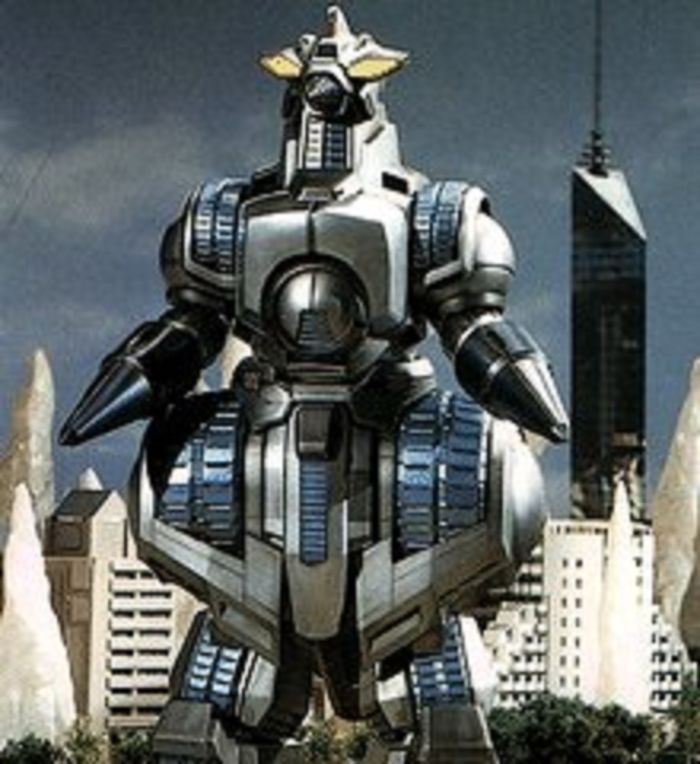 The original MechaG appeared in three more Toho films in the decade from ’93 until 2003 (Godzilla vs. Mechagodzilla II, Godzilla Against Mechagodzilla, and Godzilla: Tokyo S.O.S). And in between there was M.O.G.U.E.R.A. (Mobile Operation Godzilla Universal Expert Robot Aero-type, image at right), another robotic Godzilla first introduced in 1994’s Godzilla vs. SpaceGodzilla, built from pieces of the defeated Mechagodzilla. It could split into two different vehicles: Land Moguera and the aerial Star Falcon. After failing to destroy Godzilla, it was used to help Godzilla defeat SpaceGodzilla.
The original MechaG appeared in three more Toho films in the decade from ’93 until 2003 (Godzilla vs. Mechagodzilla II, Godzilla Against Mechagodzilla, and Godzilla: Tokyo S.O.S). And in between there was M.O.G.U.E.R.A. (Mobile Operation Godzilla Universal Expert Robot Aero-type, image at right), another robotic Godzilla first introduced in 1994’s Godzilla vs. SpaceGodzilla, built from pieces of the defeated Mechagodzilla. It could split into two different vehicles: Land Moguera and the aerial Star Falcon. After failing to destroy Godzilla, it was used to help Godzilla defeat SpaceGodzilla.
The MechaG robot was originally said to be built around bits of a slain Godzilla scavenged by aliens ( Simeons “from the Third Planet of the Black Hole”) who were trying to conquer the Earth. In the sequel, Terror of Mechagodzilla, the Simeons unleash Mechagodzilla 2 and an aquatic dinosaur called Titanosaurus on Tokyo. Godzilla arrives to defeat Mechagodzilla 2 and Titanosaurus with some help from Earth forces.
In the later Godzilla vs. Mechagodzilla II, the robot was built by the United Nations “Godzilla Countermeasures Centre” and controlled by its military branch G-Force from bits of Mecha-King Ghidorah (it also built an aerial gunship called Garuda from the parts to battle Rodan), so there’s one GvK tie-in. Garuda and Mechagodzilla combine to form Super-Mechagodzilla, but eventually, Godzilla defeats it, too.
And then in Godzilla Against Mechagodzilla, the robot (aka Kiryu) is built from Godzilla’s remains. They battle, but neither is victorious, and Godzilla retreats in the end. In Godzilla: Tokyo S.O.S., Mechagodzilla (Kiryu) and Mothra fight and eventually defeat Godzilla, but not kill him (MechaG carried Godzilla out to sea, and both plunged into the ocean). Got all that? Yes, there is inconsistency in the franchise.
The new design for MechaG 2021 is, however, superb and menacing, a fitting homage to previous renditions, and ought to be brought back in subsequent films. It really deserved more screen time.
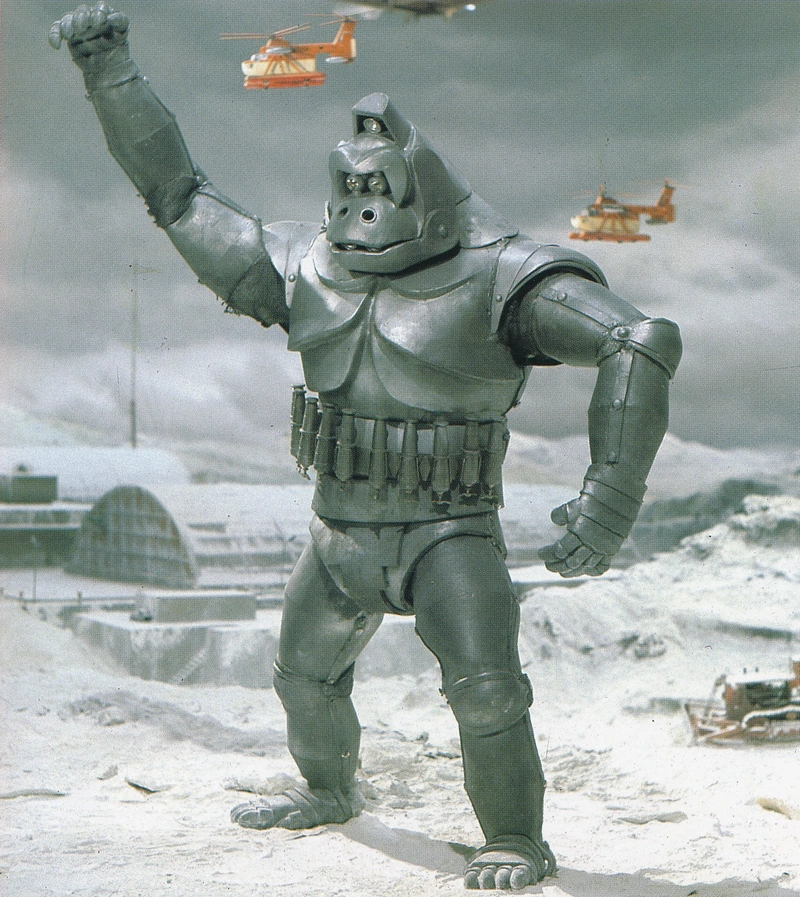 But wait… the original robot in Toho films was actually not based on Godzilla but on Kong: it was Mechani-Kong, a robot King Kong (before the licensing dispute erupted), used in the 1967 film, King Kong Escapes (Godzilla wasn’t in it). One has to wonder whether that Kong robot will surface in future MonsterVerse films to challenge the new Kong, just as the new MechaG challenged Godzilla in this one. Or is it a ‘bot too far?
But wait… the original robot in Toho films was actually not based on Godzilla but on Kong: it was Mechani-Kong, a robot King Kong (before the licensing dispute erupted), used in the 1967 film, King Kong Escapes (Godzilla wasn’t in it). One has to wonder whether that Kong robot will surface in future MonsterVerse films to challenge the new Kong, just as the new MechaG challenged Godzilla in this one. Or is it a ‘bot too far?
And there was also a Mecha-King Ghidorah in the 1991 Toho film, Godzilla vs King Ghidorah. More tie-ins with the new GvK film, and another possible resurrection for future films. Clearly, the producers and director were paying attention to the canon, even if they saw it through their own kaleidoscope. Could there be a future film in which the robot Titans come together to battle their biological counterparts? A cyber-remake of 1968’s Destroy All Monsters? Hmmm…

 But is it art, you might well ask. Well, there’s is a certain art to the older Godzilla films, if you follow the arguments about pop art, and pop culture, and why Andy Warhol matters, but let’s not digress too far. The recent Criterion release (no. 1,000 in their catalogue) of the 15 Showa-era Godzilla films was packaged in a binder replete with stunning pop-art images for each film (worth the price for these alone, one might say). These posters underscored the inherent artfulness of the Toho franchise. Aficionados of those earlier films see the subtleties and playfulness carefully crafted within them. The MonsterVerse films tip their hat to that era in many small ways, but blast past it with big, bold, and loud. No place for subtlety in the MonsterVerse. Art? No, but craft and technique, yes.
But is it art, you might well ask. Well, there’s is a certain art to the older Godzilla films, if you follow the arguments about pop art, and pop culture, and why Andy Warhol matters, but let’s not digress too far. The recent Criterion release (no. 1,000 in their catalogue) of the 15 Showa-era Godzilla films was packaged in a binder replete with stunning pop-art images for each film (worth the price for these alone, one might say). These posters underscored the inherent artfulness of the Toho franchise. Aficionados of those earlier films see the subtleties and playfulness carefully crafted within them. The MonsterVerse films tip their hat to that era in many small ways, but blast past it with big, bold, and loud. No place for subtlety in the MonsterVerse. Art? No, but craft and technique, yes.
GvK is the fourth American film in the remade franchise that began with 2014’s Gozilla, then was followed by 2017’s Kong: Skull Island (KSI), and 2019’s Godzilla: King of the Monsters (KOTM). KSI was set in 1973, so this is 48 years later, during which time Kong grew in size (approx 71 m) to closely match Godzilla’s height: Godzilla stands at 120 meters or 393 feet, while Kong is 102 meters (336 feet). Some sites list Godzilla at 121.9 m. Future MonsterVerse films in this franchise are expected, although not yet announced.
Their one-on-one battle in Hong Kong has been described as being like one of those fake WWF matches, especially with all the neon you see on the buildings. It was more show than drama. Fun, sure, but more choreography than reality. Still, that’s what most kaiju fans love: monster battles, the bigger the better.
The hollow earth theory and discovery, of course, paves the way for additional MonsterVerse films to be set in that space (or kaiju to come from it), but I cannot recall the concept being part of any previous Kong or Godzilla films. Apparently, it was used in a script for a never-made 1955 film, Bride of Godzilla. It was, of course, the central theme in Jules Verne’s Journey to the Centres of the Earth (1864), and in Edgar Rice Burroughs’ Pellucidar series (seven of his best novels, published between 1914 and 1963). This GvK hollow world seems to take some from all of these as inspirations, with a dash of H.P. Lovecraft thrown in.
Hollow earth allows a lot of leeway for creating new monsters and fantasy environments akin to the throne room and ruins in GvK (apparently Kong’s “ancestral home”), and maybe even add some people (a la ERB’s Pellucidar), but as shown in GvK it lacks an essential component for Godzilla films: cities to ruin. True, not every Toho Godzilla film featured Big G rampaging through a city, but most did. A few were set on an island (later named Monster Island) to keep the budgets down — those miniature city sets were expensive and time-consuming to build, and couldn’t be re-used later, once trampled — but the city-stomp was a fan favourite, and featured in most of the films.
And there’s a big question mark in the sequence where Godzilla blasts a hole through the earth opening into the hollow earth, big enough for Kong to climb through. It doesn’t make sense. If G has that much energy in his blast to carve through thousands of kilometres of rock and metal in a minute or less, he should have easily destroyed MechaG or Kong with his breath, along with a large swatch of Hong Kong and maybe even mainland China. But wouldn’t the tunnel walls be lined with molten rock? Wouldn’t it be far too hot to climb for days, if not weeks? Wouldn’t there be a plume of ash rising from the hole, like a volcano? And be on both ends?
Wouldn’t water (groundwater, or seawater) fall down the hole (apparently there are other entrances into the hollow earth, but only one other is shown, in Antarctica) and pretty soon the oceans up here would empty to make hollow earth into a giant fishbowl? So what becomes of this new tunnel to hollow earth that opens up in the middle of Hong Kong? Where does the light come from in the hollow earth? How does photosynthesis work down there? How did the other animals and plants get there? Is it a convergent evolution? Parallel evolution?
I know, I know, it’s a movie, but it’s also junk science.
Godzilla has had a mixed role through the franchise. In the original film, he (okay, the monster’s sex isn’t mentioned, but stick with the pronoun for now) was an enemy attacking humans and their cities (the film was an allegory about the dangers of atomic radiation, nuclear war, and uncontrolled science leading to hubris aka Frankenstein). Slowly over several films in the franchise, he became a defender and even friend to humankind, protecting us from aliens and other giant monsters. Then in the mid-80s he was recast as the enemy, and again in the later films towards the end of the franchise, then a sort-of-defender again. His role has never been clear: it varies. In the MonsterVerse series, he starts out as an enemy who becomes a sort-of friend who saves humankind from other kaiju (MUTOs or Massive Unidentified Terrestrial Organisms in the 2014 film, and other monsters collectively known as Titans — 17 of which appeared in KOTM alone). In GvK he returns as an enemy, sort-of, who eventually turns out to be a sort-of friend by stopping MechaG. Got that?
I think the message is that Big G has his own agenda. You never know what he’s going to do next. And that suits the narrative that has been present throughout the franchise. Kong always seems a friend. Sort-of.
Kong is the real protagonist in the film and, suitably, gets more screen time than Godzilla. And he’s clearly intelligent, learning sign language, figuring out puzzles (the handprint to open the door), and using tools (the axe, a deus ex machine device that has never featured in any previous Kong films). He’s more human-friendly than in KSI. But I wish the writers would not have the villains keep calling him a “monkey.” If he is related to any normal, earthly species, it is to the apes. And, sure, it’s a trope for villains to demean Kong, but come on. They can’t be that stupid and still be worthwhile villains. But even the most intellectual villain (the Godzilla-obsessed head of APEX and designer of MechaG) seems little more threatening than a toon villain from Despicable Me when he bloviates on becoming the apex predator (note the pun).
And the human villains in the film, aside from being cutouts, are disposed of far too easily. At the same time, the heroic good humans survive explosions, crashes, and kaiju battles with hardly a scratch. It’s like a western with kaiju; all it needed was the black and white hats to identify them.
The film gave us a glimpse of Kong’s potentially positive relationship with people (like when he saves the ship from being sunk during the water battle, righting it, thus saving both heroes and villains), but left me wondering how or even if that might work post-battle. After all, he was complicit in wrecking Hong Kong. And then he left for hollow earth to swing among the trees many thousands of kilometres beneath our feet. What is his future? Will he develop his communication skills more?
Godzilla seems more feral in GvK than in previous films. Fewer signs of intelligence knit his scaly brow especially compared to Kong (of course, the ape’s human-like face is more capable of showing human-like emotion than the giant lizard’s). Godzilla seemed to show real awareness or consciousness only a very few times: in the fight scene where he defeats Kong and accepts the latter’s surrender rather than kill him (actually they both growl and G seems to understand Kong means “I give up…”), and again when he breathes his atomic fire into Kong’s axe, apparently recognizing it gave the weapon added strength. But otherwise, he seems more beastlike throughout the majority of the time he’s onscreen.
This raises another question: are the Titans nothing more than big beasts? Moved by hormones and instinct instead of reason? That seems less threatening than if they have intelligence. Recall Jurassic Park: the big dinosaurs are scary and dangerous, but easily fooled. The real threats are the smaller velociraptors which can reason, plan, communicate, and think. I want the MonsterVerse kaiju to be smart, to have to be out-thought, and outplayed, not simply out-blasted. Perhaps Kong is the genius among the kaiju.
But is the film fun? Yes, of course. It’s an action film, and it delivers. You’re on a rollercoaster ride from start to finish with little time to ponder the meaning of things. It doesn’t pretend to be anything else. You get introduced to the kaiju early, get to witness destruction and mayhem quickly and frequently, and it gallops eagerly towards the final battle, which is a brawl worthy of the franchise. So you get a couple of hours of easy viewing fun, without any real strain on your brain.
Oh, wait… you want to know who wins? Watch the film. Even if you’re not a Godzilla fan, you’ll get a kick out of seeing the humongous Kong.
I’d give it 3.5 stars out of five, and worthy of a second viewing (although Susan would disagree with the latter).
Published sources for my notes on the Toho films include:
-
- Godzilla FAQ: All That’s Left to Know About The King of Monsters, by Brian Solomon, Applause Theatre and Cinema Books, 2017, 358 pages.
- The Big Book of Japanese Giant Monster Movies, Volume 1: 1954-1982, by John Lemay, Bicep Books, 2017, 294 pages, revised and expanded edition.
- The Big Book of Japanese Giant Monster Movies, Volume 2: 1984-2014, by John Lemay, Bicep Books, 2017, 230 pages, revised and expanded edition.
- Godzilla On My Mind: Fifty Years of The King of Monsters, by William Tsutsui, Palgrave Macmillan, 2004, 240 pages.



Another question: that supersonic railway from APEX US to its Hong Kong HQ… why does it read the speed in anachronistic MPH and not Km/h? Is it steam powered? What modern technology uses MPH? That’s just risibly antiquated.
Pingback: Books for the Kaiju Aficionado – Scripturient
Pingback: Reviewing Godzilla Films – Scripturient